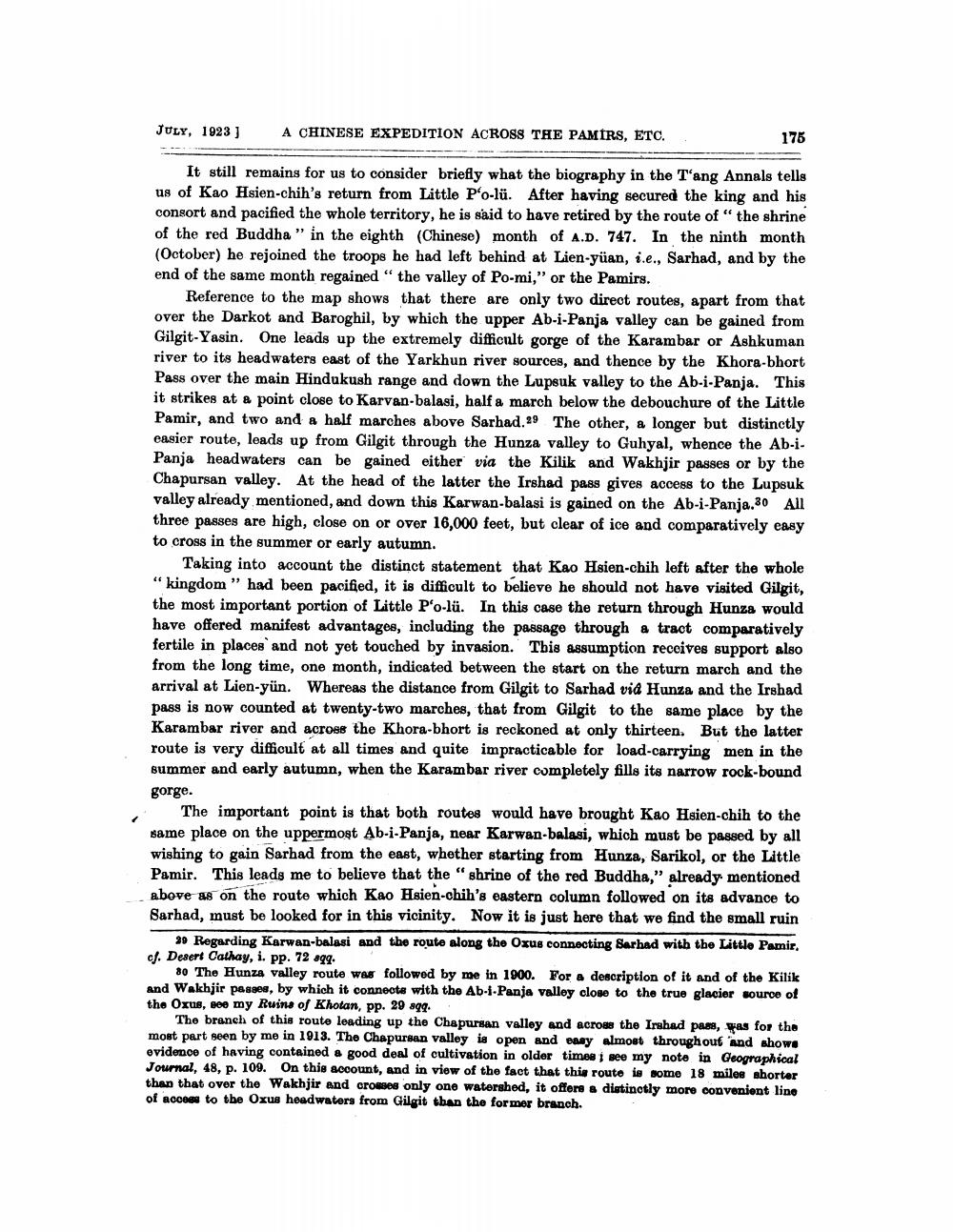________________
JULY, 1923]
A CHINESE EXPEDITION ACROSS THE PAMIRS, ETC.
175
It still remains for us to consider briefly what the biography in the T'ang Annals tells us of Kao Hsien-chih's return from Little Po-lü. After having secured the king and his consort and pacified the whole territory, he is said to have retired by the route of “the shrine of the red Buddha" in the eighth (Chinese) month of A.D. 747. In the ninth month (October) he rejoined the troops he had left behind at Lien-yuan, i.e., Sarhad, and by the end of the same month regained “the valley of Po-mi," or the Pamirs.
Reference to the map shows that there are only two direct routes, apart from that over the Darkot and Baroghil, by which the upper Ab-i-Panja valley can be gained from Gilgit-Yasin. One leads up the extremely difficult gorge of the Karambar or Ashkuman river to its headwaters east of the Yarkhun river sources, and thence by the Khora-bhort Pass over the main Hindukush range and down the Lupsuk valley to the Ab-i-Panja. This it strikes at a point close to Karvan-balasi, half a march below the debouchure of the Little Pamir, and two and a half marches above Sarhad.29 The other, a longer but distinctly easier route, leads up from Gilgit through the Hunza valley to Guhyal, whence the Ab-i. Panja headwaters can be gained either via the Kilik and Wakhjir passes or by the Chapursan valley. At the head of the latter the Irshad pass gives access to the Lupsuk valley already mentioned, and down this Karwan-balasi is gained on the Ab-i-Panja.30 All three passes are high, close on or over 16,000 feet, but clear of ice and comparatively easy to cross in the summer or early autumn.
Taking into account the distinct statement that Kao Hsien-chih left after the whole "kingdom" had been pacified, it is difficult to believe he should not have visited Gilgit, the most important portion of Little Po-lü. In this case the return through Hunza would have offered manifest advantages, including the passage through a tract comparatively fertile in places and not yet touched by invasion. This assumption receives support also from the long time, one month, indicated between the start on the return march and the arrival at Lien-yün. Whereas the distance from Gilgit to Sarhad vid Hunza and the Irshad pass is now counted at twenty-two marches, that from Gilgit to the same place by the Karambar river and across the Khora-bhort is reckoned at only thirteen. But the latter route is very difficult at all times and quite impracticable for load-carrying men in the summer and early autumn, when the Karambar river completely fills its narrow rock-bound gorge.
The important point is that both routes would have brought Kao Hsien-chih to the same place on the uppermost Ab-i-Panja, near Karwan-balasi, which must be passed by all wishing to gain Sarhad from the east, whether starting from Hunza, Sarikol, or the Little Pamir. This leads me to believe that the "shrine of the red Buddha,” already mentioned above as on the route which Kao Hsien-chih's eastern column followed on its advance to Sarhad, must be looked for in this vicinity. Now it is just here that we find the small ruin
30 Regarding Karwan-balasi and the route along the Oxus connecting Sarhad with the Little Pamir, of. Desert Cathay, i. pp. 72 agg.
80 The Hunza valley route was followed by me in 1900. For a description of it and of the Kilik and Wakhjir pages, by which it conneots with the Ab-i-Panja valley close to the true glacier source of the Oxus, see my Ruins of Khotan, pp. 29 899.
The branch of this route leading up the Chapursan valley and across the Irshad pass, was for the most part seen by me in 1013. The Chapursen valley is open and easy almost throughout and showe evidence of having contained a good deal of cultivation in older time i see my note in Geographical Journal, 48, p. 109. On this account, and in view of the fact that this route is some 18 miles shorter than that over the Wakhjir and crosses only one watershed, it offers a distinctly more convenient lino of acown to the Oxus headwaters from Gilgit than the former branch.




